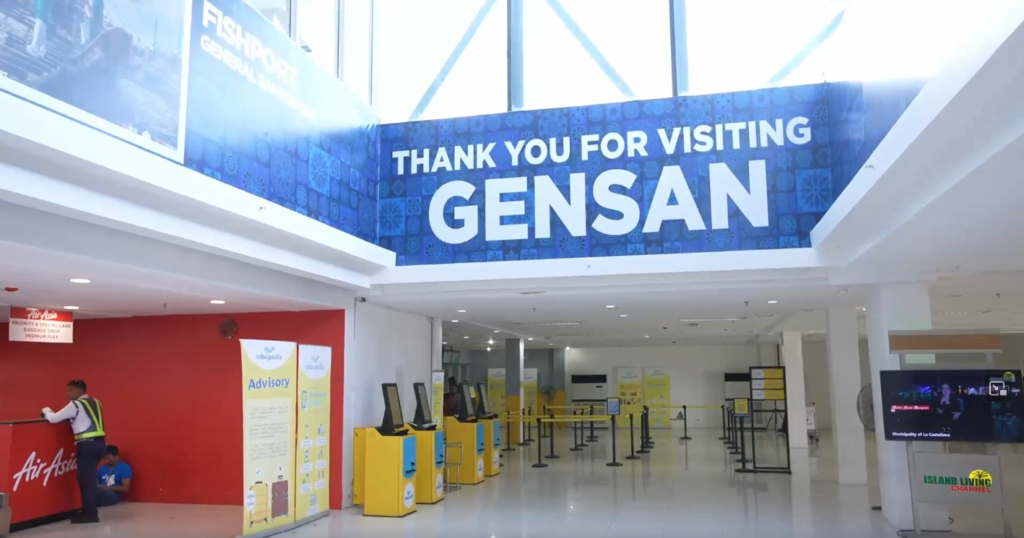
GenSan Airport: A Comprehensive Guide for Tourists

General Santos International Airport, or as many like to call it, “GenSan Airport or Tambler Airport,” isn’t just any airport on Mindanao island—it’s the BIGGEST.
Located in the city of General Santos, it’s more than an airport. It’s the heartbeat of Soccsksargen’s air transport.
And let me tell you: it’s not just about its size. It is the lifeblood of transportation and commerce for the city and its surrounding areas.

When touching down at General Santos International Airport, you’re only a short, scenic drive away from diving into the vibrant core of General Santos City.
Located 14 kilometers (8.7 mi) from the city’s bustling central business district, this Airport’s strategic positioning is no coincidence.
Here’s your fast-track route:
- The 6-kilometer (3.7 mi) Philippine-American Friendship Road: A concrete testament to shared histories and a direct link from the Airport.
- General Santos Diversion Road: Stretching for 30 kilometers, this well-maintained path channels you smoothly to the Pan-Philippine Highway.
A Brief History of the GenSan Airport
The General Santos International Airport (GES), since its inception in 1993, set forth with a vision of becoming the largest Airport in Mindanao. This vision was rooted deeply within the core values and aspirations of General Santos City.
A significant chunk of the establishment funds for General Santos International Airport, a generous US$47.6 million, came as a grant from the U.S. Government through USAID.
In addition, the local government and the Philippines’ DOTC showed faith in the project, contributing 25% of the total cost.
Situated in Barangay Fatima, General Santos International Airport stretches over a 5,994,577-square-meter area and lies a mere 14km away from General Santos City’s CBD.
- Inception and Initial Days of General Santos International Airport:
- 1996 saw its grand opening as the paramount Airport of Mindanao, placing General Santos City on the map.
- Philippine Airlines (PAL) swiftly transitioned its Iloilo and Cebu city routes from Buayan Airport to this state-of-the-art hub.
- The local government facilitated special direct flights using the Boeing 737-300, primarily for the Palarong Pambansa sports event attendees in General Santos City.
- 1996 saw its grand opening as the paramount Airport of Mindanao, placing General Santos City on the map.
With 1997 ushering in, PAL amplified its services from General Santos International Airport, initiating thrice-weekly direct flights to Manila using the Airbus A300B4.

This frequency soon turned daily by December of the same year. But as time unfolded, PAL faced financial challenges by the end of the 90s. This led to the discontinuation several routes, leaving only the Manila service active.
- International Highlights & Modern Evolution of General Santos International Airport:
- GES’s international stature was marked with ex-President Fidel V. Ramos’ chartered flight return from Bangkok in the mid-90s.
- GES’s international stature was marked with ex-President Fidel V. Ramos’ chartered flight return from Bangkok in the mid-90s.
- 2003 brought weekly connectivity between Manado, Indonesia, and General Santos International Airport, thanks to Merpati Nusantara Airlines.
- 2006 was marked by Cebu Pacific launching daily flights between Manila and General Santos International Airport.
- 2013 had General Santos International Airport stepping up, managing diverted flights due to the Francisco Bangoy International Airport shutdown.
- The booming tuna exports and a surge in passenger numbers have seen frequent visits by bigger aircraft like the Boeing 777.
Airport Facilities and Structures
Design Inspiration:
The Airport’s facade borrows its design cues from the fins of the yellow-fin tuna. It’s a nod to the unique identity of the region.
Expansion Potential
The existing second floor of the terminal has been smartly designed, priming for vertical growth and accommodating boarding bridges.
VIP Treatment
If you’re flying business with Philippine Airlines, their Mabuhay Lounge offers an exclusive experience for its premium passengers.
Growth Over Time:
- Before 2017, The terminal covered an area of 4,029 square meters and had a yearly capacity of 800,000 passengers.
- Post Facelift (2017-2021): The terminal expanded impressively to 12,240 square meters, boosting its annual capacity to two million passengers. Additionally, the upgrade included the introduction of jet bridges.
Apron Capacity
GES can efficiently handle up to seven aircraft simultaneously on its apron.

Runway Specs
GES boasts a hefty 3,227-meter (10,587 ft) runway, stretching out at a width of 45 meters (148 ft), famously known as runway 17/35.
Construction Details:
This isn’t just any runway. It’s meticulously crafted from reinforced concrete and macadam, ensuring durability and smooth operations.
Ranking in the Philippines:
Hold onto your hats! GES’s runway ranks as the third-longest in the Philippines. It stands tall right after:
- Ninoy Aquino International Airport’s Runway 06/24 (3,737 meters, 12,260 ft)
- Mactan–Cebu International Airport’s Runway 04/22 (3,300 meters, 10,800 ft).
Aircraft Handling Prowess
Size matters and GES proves it. Its runway is more than capable of welcoming the mammoth Airbus A380.
Mindanao Milestone
Setting records, GES became the first Airport in Mindanao to witness the grandeur of the Boeing 747 during both landings and take-offs.
Airlines and Destinations
GES is served by the following airlines:
* AirAsia
* PAL Express
It offers direct flights to and from the following destinations:
* Manila
* Cebu
* Davao
* Zamboanga
* Kalibo
Cargo
When you think GES, think more than just flights. General Santos International Airport is the epicenter of the country’s tuna industry. Here’s why:
- Major Air Cargo Powerhouse: it isn’t just about passengers; it’s a thriving nucleus for air cargo, especially for coveted tuna exports.
- Tuna Central: Right at the Airport’s doorstep, you’ll find a bustling hive of tuna processing and packing plants. Fresh catch? Packed and prepped for the world right here.
- Prime Location: Situated tantalizingly close to the abundant fishing grounds of the Celebes Sea, GES holds an excellent seat at the seafood table. It’s not just an airport; it’s a strategic launchpad for the booming tuna trade.

Why Choose GES?
Travelers often have a checklist of what they’re looking for in an airport. For those heading to or from General Santos City and the neighboring areas, GES stands out for several compelling reasons:
Convenience
For travelers eager to minimize transit times, the proximity of General Santos International Airport to the city center is a significant advantage. Situated just 14 kilometers away, travelers can easily and quickly access the city’s heart.
Connectivity
For travelers keen on optimal routing, General Santos International Airport boasts direct flights to and from several major cities within the Philippines. Plus, international travelers aren’t left out; select international destinations are accessible directly from this hub.
Affordability
Budget-conscious travelers will be pleased to note that General Santos International Airport offers competitive airfares across various airlines, making their journey more cost-effective.
Safety and Security
For travelers for whom safety is paramount, General Santos International Airport doesn’t disappoint. The Airport maintains a robust commitment to ensuring that travelers’ safety and security are always upheld.
How to get to the Airport from any point in the city?
Private Car or Taxi: You can hire a taxi from the city to take you directly to the Airport. This option is convenient and quick, although it might be more costly than public transportation. The journey by car or taxi typically takes about 30 minutes to an hour, depending on traffic conditions.
Tricycles or Pedicabs: These are common means of transport for short distances within the city. However, it’s less conventional but still possible for longer distances, such as going to the Airport, especially if you’re traveling light.
Jeepneys: Jeepneys are a popular mode of public transportation in the Philippines. Some jeepneys ply routes passing by areas near the Airport. You should take a tricycle or walk the remaining distance.
Vans or UV Express: Some vans operate routes between the city and the Airport. They usually have specific pick-up points in the city.
Frequently asked questions
What is the airport code?
When scanning flight boards or booking your next trip, a three-letter acronym stands out: GES. What might seem like just a random mix of letters is your passport to one of Southeast Asia’s hidden treasures. That’s the IATA code representing General Santos City airport.
How do you get to SM GenSan from the Airport?
- Distance: Approximately 16 to 20 kilometers, depending on the chosen route.
- Travel Time: Under typical traffic conditions, it should take 30 to 45 minutes by car.
- Route Options:
- Via Pan-Philippine Hwy/AH26 – This route is straightforward and commonly used.
- Via Philippine-American Friendship Road – An alternative route that might be faster during peak hours.
- Transportation Options:
- Taxi: Available at the Airport, this is a convenient way to reach SM Gensan.
- Jeepney or Multicab: A more local mode of transport; however, you may need to switch rides or take a tricycle for the last stretch.
- Car Rentals: Several car rental services operate from the Airport.
- Tricycles: This is not really the best mode of transportation, but it can get you there.
Remember, travel times can vary depending on the time of day and traffic conditions. It’s always a good idea to check for real-time updates or ask locals for advice on the quickest route.
What is their contact number?
If you need to reach General Santos International Airport, you can contact them at the following phone number:
(083) 553 1277
How to get from the Airport to Koronadal
Traveling from General Santos International Airport to Koronadal City:
- Distance: Approximately 50-60 kilometers, depending on the chosen route.
- Travel Time: The drive typically takes 1 to 1.5 hours, but this can vary depending on traffic and the specific route.
- Route Options:
- Via General Santos Drive: This is one of the most direct routes, leading you straight to Koronadal City from General Santos.
- There might be alternative routes or side roads. Still, the General Santos Drive is the primary highway connecting the two areas.
- Transportation Options:
- Bus: Some buses ply the Gensan-Koronadal route regularly.
- Vans/UV Express: Shared vans or UV Express services are popular modes of transportation between these two cities.
- Private Car or Taxi: This might be a more expensive option but provides flexibility in travel time and convenience.
It’s always a good idea to check current road conditions or travel advisories before starting your journey.